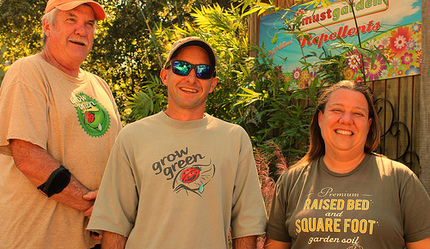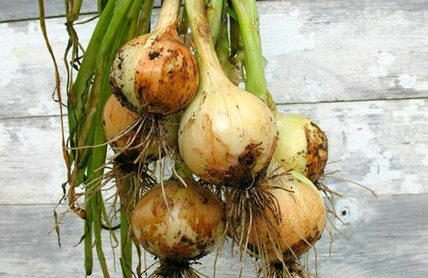
tel: 512 280-1192 Friday, Nov 8 2013
Nursery notes: Lots of fall and winter garden vegetables in stock.
2 gallon roses 50% off (excludes 3 gal. knockouts). $1 off bagged

goods, composts, potting soils, and mulches. 10% off trees $5 off
corn gluten - sale price $39.99. Last chance to control winter weeds
before they emerge. / Onion sets arriving this Wednesday: Southern
Belle red, white Bermuda, and Texas 1015y.

Free Lecture, 2 p.m. this Sunday: How to have a Four Seasons
Garden. Learn from master gardener Amanda Moon (above right)
all the basics for making the most out of your veggie gardens year
round, including crop rotation, planting schedules, companion plants,
shade in the summer and winter protection, fertilizing and watering
techniques. Nov. 10. (photo l-r: Mike, Jerry, Amanda.)
______________________________________________________
If your lawn's gone... what are some good plant choices to cover the
bare ground? Some sage advice offered by author Pam Penick during
her recent visit to the nursery: 1. Vines: Asian jasmine, star jasmine,
sweet potato vines (annuals), avoid English ivy (invasive!) 2. Creep-
ing plants: silver ponyfoot, purple heart, snake herb, hardy plum-
bago, thyme, lamb's ear, horseherb, frogfruit, Gregg dalea, pigeonberry,
wooly stemodia. 3. Succulents: Blue Spruce sedum, maybe Angelina
sedum, bulbine. Visit Pam Penick for more info.
_____________________________________________________
want to read a recent New Yorker article by Lauren Collins on the
quest for the world's hottest chili: fire eater
____________________________________________________
Central Texas Gardener KLRU TV. In studio guest Mary Irish
chats with Tom about her latest book, Texas Getting Started Guide.
On tour, a visit to Texas newomer Kathleen Lorsbach's waterwise
garden. Sat. noon, 4 p.m. or Sun. at 9 a.m. www.klru
_____________________________________________________
Coming next Sunday: How to Re-wild a 20-acre Hill Country
Garden. 2 p.m.. Learn from expert Walter Stewart, who has toiled
for years to return his Bee Caves-area garden to the splendor of its
natural state. Nov. 17. Free.

Texas 1015y “Super-Sweet” - so sweet that it can be eaten like an apple!
Top 5 Onions for Austin Gardens
by Chris Winslow
For many of my friends, the arrival of November signals the start of
the deer and wild turkey season. For me, it’s onion planting time.
While Baker and Oliver hone their hunting skills over at the ranch
in Brackettville, I’m in my backyard planting this season’s crop.
I am often asked about ‘the key to success’ with onions, and I
always tell gardeners that they first have to know which variety is
best suited to the area where they live.
Here in central Texas, we plant short-day onions. These grow during
the short days of winter and are ready for harvest when the days
become longer in the spring.
Short day onions mature in roughly 120 days, and you can plant them
from the middle of this month through late winter. It’s important to
know that the earlier you plant them, the bigger the onions will grow.
My top five onion choices for Hay County:
1. Texas 1015y “Super-Sweet” Probably the most popular onion
in Texas. The 1015 is globe-shaped, yellow, and can grow up to 6
inches in diameter. It’s so sweet that it can be eaten like an apple!
2. Texas Early White A new, sweet, white onion that just won the
2012 direct gardening “Green Thumb” award for its flavor, ease-of-
growing, and disease resistance. Matures in 105 days and is globe
shaped. Mature width: 5 inches.
3. Southern Belle Red A large, globe-shaped, sweet onion that
grows to 4 inches in diameter. It’s the sweetest of the red short day
onions.
4. White Bermuda A flat, sweet, white onion that grows to 3 to
4 inches. It’s an excellent onion to harvest early for scallions. This
heirloom onion originated in the Canary Islands.
5. Creole Red A pungent, new red onion that is globe shaped and
reaches 3 to 4 inches across at maturity. A strong flavor that’s works
well for Cajun cooking.
These onions need a sunny garden location with loose, well drained
soil. Mixing lots of organic compost with our native soils is a must.
For fertilizer, they like a lot of phosphate to start. Organic bone meal
(0- 10-0) mixed into the soil before planting work well. As they start
to grow, add a higher nitrogen fertilizer as a top dress. Blood meal
(12-0-0) or Ladybug organic fertilizer (8-2-4) is very effective.
Plant your onions 1 inch deep and 4 to 6 inches apart. If you like to
harvest green onions early, plant them 2 inches apart and harvest
every other onion as they grow.
Rows should be at least 8 inches apart so that there are enough
nutrients to go around. Onions like water, so keep up with a regular
watering schedule. (They will not grow in dry soil.) If the leaves
begin to yellow, that’s probably a sign of too much water.
You can harvest your onions in the spring when the tops turn brown
and begin to fall over. This should be somewhere between mid-
April and mid –May.
Finally, onions are easy to store. My crop from May of this year is
still holding up well in the crisper.
Take advantage of the season and try your hand at being an onion
gardener. I know that’s what I’ll be doing!
Happy Gardening everyone.
 Visit the website: www.itsaboutthyme.com
Visit the website: www.itsaboutthyme.com Visit the nursery:11726 Manchaca Road, Austin, 78748 Like us
on facebook